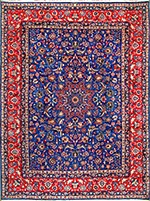Textiles Studies
Date of this Version
2000
Document Type
Article
Citation
Encyclopædia Iranica, Vol. X, Fasc. 3, pp. 237-239
https://iranicaonline.org/articles/gabba
Abstract
GABBA (gava in Kurdish and Lori, Īzadpanāh, s.v.; ḵersak in Baḵtīārī, Digard, pp. 128-31), a hand-woven pile rug of coarse quality and medium size (90 x 150 cm or larger) characterized by an abstract design that relies upon open fields of color and a playfulness with geometry. This kind of rug is common among the tribes of the Zagros (Kurdish, Lori-speaking ethnic groups, Qašqāʾīs). The first known reference to gabba is found in a farmān by Shah Ṭahmāsp (r. 930-84/1524-76) dating to the middle of the 16th century (Opie, 1992, p. 124). Gabbas were said to have originated in Lorestān (mainly from the Ḵorramābād, Borūjerd, and Alīgūdarz regions), whence its use and production spread northward among the Kurds as far as Sanandaj, Nehāvand, Bījār, Kabūdarāhang, and southward in Fārs among the Qašqāʾīs (Tanāvolī, 1977; Tanavoli and Amanolahi; Opie) and as far as Šūl, a village on the edge of the Bušehr province which was reputed to produce the best gabbas. Typically, there is minimal pattern with an occasional stick figure or simply stylized animals on a gabba.
Included in
Art and Materials Conservation Commons, Art Practice Commons, Fiber, Textile, and Weaving Arts Commons, Indigenous Studies Commons, Museum Studies Commons


Comments
©2024 ENCYCLOPÆDIA IRANICA FOUNDATION, INC.